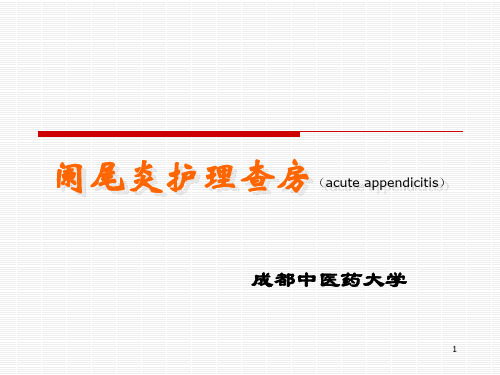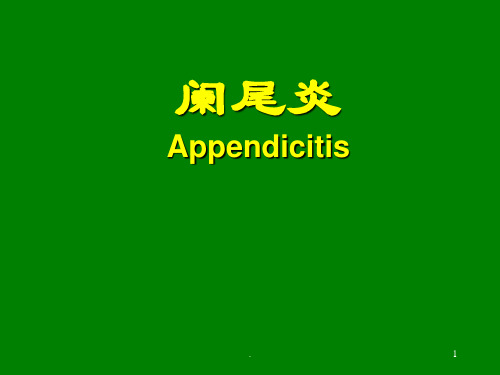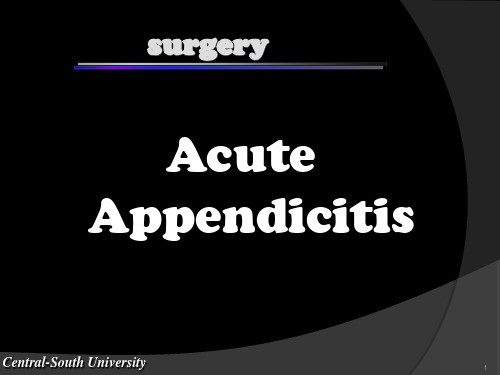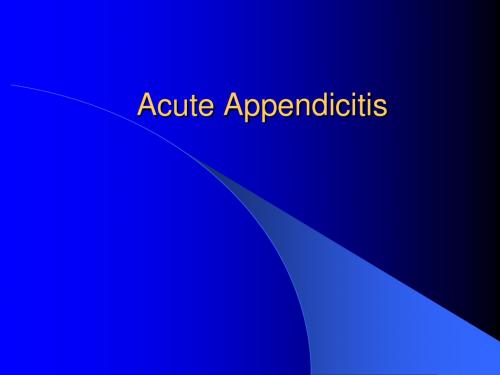阑尾炎英文 ppt课件
合集下载
阑尾炎(英文)PPT演示课件

In pregnancy, the appendix can be shifted and patients can present with RUQ pain
15
Pathophysiology
1
2
Anatomy
3
Varied anatomy
haustra of colon
Length: 5~10 cm, narrow lumen
4
Epidemiology
The most common acute abdomen disease The incidence of appendectomy appears to
This triggers somatic pain fibers, innervating the peritoneal structures
Typically causing pain in the RLQ
13
Pathophysiology
The change in stimulation form visceral to somatic pain fibers explains the classic migration of pain in the periumbilical area to the RLQ seen with acute appendicitis.
9
Etiology
Eventually the pressure exceeds capillary perfusion pressure and venous and lymphatic drainage are obstructed.
With vascular compromise, epithelial mucosa breaks down and bacterial invasion by bowel flora occurs.
15
Pathophysiology
1
2
Anatomy
3
Varied anatomy
haustra of colon
Length: 5~10 cm, narrow lumen
4
Epidemiology
The most common acute abdomen disease The incidence of appendectomy appears to
This triggers somatic pain fibers, innervating the peritoneal structures
Typically causing pain in the RLQ
13
Pathophysiology
The change in stimulation form visceral to somatic pain fibers explains the classic migration of pain in the periumbilical area to the RLQ seen with acute appendicitis.
9
Etiology
Eventually the pressure exceeds capillary perfusion pressure and venous and lymphatic drainage are obstructed.
With vascular compromise, epithelial mucosa breaks down and bacterial invasion by bowel flora occurs.
阑尾炎护理查房PPT课件

阑尾炎护理查房(acute appendicitis)
成都中医药大学
1
概述
阑尾炎是指发生在阑尾的炎症反应,是常 见急腹症,分急性和慢性,急性阑尾炎若 能及时、正确处理疗效好,若延误诊治, 引起坏疽、穿孔,导致弥漫性腹膜炎,将 危及生命。
2
【解剖概要】
位于右下腹,体表投影于脐与 髂前上棘连线中外1/3交界处, 为阑尾手术切口的标记点。
1、炎症消退:单纯性→可消退不复发; 化脓性→即使炎症消退但易复发
2、炎症局限:→阑尾周围脓肿 3、炎症扩散:→弥漫性腹膜炎、化脓
性门静脉炎、细菌性肝脓肿、感染性休克。
6
【临床表现】
症状 1、腹痛 - 为最早出现的症状
*①转移性右下腹痛( 由脐周→右下腹
→全腹) ②呈持续性、针刺样,可阵发性加剧 ③穿孔时突然减轻→随后逐渐加剧 2、胃肠道症状 - 恶心、呕吐、便秘
② 全身和消化道症状出现早而显著。 ③ 转移性右下腹痛和肌紧张不明显。 ④ 病情发展迅速、严重,易穿孔形成腹 膜炎。
11
【处理原则】
(一)手术治疗 除早期单纯性阑尾炎或有手术禁忌证外,均 应 早期手术 1、阑尾切除术 (适于单纯性) 2、阑尾切除腹腔引流术(化脓性、坏疽性、 穿孔性) 3、阑尾脓肿切开引流术(阑尾周围脓肿)(一 般三月后再切除阑尾)
减轻或缓解疼痛
(二)潜在并发症 预防和及时发现 (出血、切口感染、 并发症
腹腔脓肿等 )
15
护理措施
(一)手术前护理
1、心理护理 2、观察:全身状况T↑ P↑ WBC↑变化(4-6h
测T一次,6-12h查血象一次)腹膜刺激征;观 察期禁用止痛药、泻剂及灌肠。 3、术前准备 禁食(胃肠减压一般可不用) 补液 应用抗生素 其他准备(备皮、签字)
成都中医药大学
1
概述
阑尾炎是指发生在阑尾的炎症反应,是常 见急腹症,分急性和慢性,急性阑尾炎若 能及时、正确处理疗效好,若延误诊治, 引起坏疽、穿孔,导致弥漫性腹膜炎,将 危及生命。
2
【解剖概要】
位于右下腹,体表投影于脐与 髂前上棘连线中外1/3交界处, 为阑尾手术切口的标记点。
1、炎症消退:单纯性→可消退不复发; 化脓性→即使炎症消退但易复发
2、炎症局限:→阑尾周围脓肿 3、炎症扩散:→弥漫性腹膜炎、化脓
性门静脉炎、细菌性肝脓肿、感染性休克。
6
【临床表现】
症状 1、腹痛 - 为最早出现的症状
*①转移性右下腹痛( 由脐周→右下腹
→全腹) ②呈持续性、针刺样,可阵发性加剧 ③穿孔时突然减轻→随后逐渐加剧 2、胃肠道症状 - 恶心、呕吐、便秘
② 全身和消化道症状出现早而显著。 ③ 转移性右下腹痛和肌紧张不明显。 ④ 病情发展迅速、严重,易穿孔形成腹 膜炎。
11
【处理原则】
(一)手术治疗 除早期单纯性阑尾炎或有手术禁忌证外,均 应 早期手术 1、阑尾切除术 (适于单纯性) 2、阑尾切除腹腔引流术(化脓性、坏疽性、 穿孔性) 3、阑尾脓肿切开引流术(阑尾周围脓肿)(一 般三月后再切除阑尾)
减轻或缓解疼痛
(二)潜在并发症 预防和及时发现 (出血、切口感染、 并发症
腹腔脓肿等 )
15
护理措施
(一)手术前护理
1、心理护理 2、观察:全身状况T↑ P↑ WBC↑变化(4-6h
测T一次,6-12h查血象一次)腹膜刺激征;观 察期禁用止痛药、泻剂及灌肠。 3、术前准备 禁食(胃肠减压一般可不用) 补液 应用抗生素 其他准备(备皮、签字)
阑尾炎护理查房PPT课件

精品PPT
【护理诊断】
术前
1.疼痛:阑尾管腔阻塞后扩张、收缩引起的内 脏神经反射性疼痛 2.焦虑 :与环境陌生及担心疾病预后有关
术后
1、潜在并发症:出血,切口感染,粘连性肠梗 阻 阑尾残株炎
2、舒适的改变:与切口疼痛及引流管的放置有 关
精品PPT
3、自理能力下降:与术后切口疼痛,放 置引流管有关
精品PPT
【健康教育】
(一)患者及时就诊。 (二)应摄入营养丰富齐全的食物,以利于
精品PPT
【临床表现】
体征:
1、右下腹压痛 麦氏点 2、腹膜刺激征 肌紧张、压痛、反跳痛、肠鸣
音减弱或消失 3、右下腹包块 边界不清、固定 4、特殊检查
结肠充气试验(Rovsing氏征)(+) 腰大肌试验 (+)(后位) 闭孔内肌试验(+)(低位) 直肠指检 直肠右前方触痛 (盆位)痛性包块(盆腔 脓肿)
精品PPT
实验室检查: 8-13 血常规 wbc 15.42×109/L↑ 中性粒细胞百分比 91.3%↑ 中性粒细胞计数 14.08×109/L↑ 降钙素原 0.13ng/mL↑
精品PPT
8-15 8-18
血常规 wbc 13.9×109/L↑ 中性粒细胞百分比 92%↑ 中性粒细胞计数 12.79×109/L↑
目标:患者术后不适程度减轻,得到较好休息 措施:
1、提供适宜的环境 2、遵医嘱给予消炎,止痛的药物 3、做好切口及引流管的护理,嘱患者避免牵拉, 防止引流管脱出 4、尽可能满足患者的合理需求 评价:患者的舒适需求基本得到满足
精品PPT
五、体温过高:与手术切口化脓反应有关 目标:住院期间患者体温降至正常 措施:1、及时报告医生病人的发热情况,观察热
效果非常好 其他:褥疮、伤口不愈合、以及糖尿病足
【护理诊断】
术前
1.疼痛:阑尾管腔阻塞后扩张、收缩引起的内 脏神经反射性疼痛 2.焦虑 :与环境陌生及担心疾病预后有关
术后
1、潜在并发症:出血,切口感染,粘连性肠梗 阻 阑尾残株炎
2、舒适的改变:与切口疼痛及引流管的放置有 关
精品PPT
3、自理能力下降:与术后切口疼痛,放 置引流管有关
精品PPT
【健康教育】
(一)患者及时就诊。 (二)应摄入营养丰富齐全的食物,以利于
精品PPT
【临床表现】
体征:
1、右下腹压痛 麦氏点 2、腹膜刺激征 肌紧张、压痛、反跳痛、肠鸣
音减弱或消失 3、右下腹包块 边界不清、固定 4、特殊检查
结肠充气试验(Rovsing氏征)(+) 腰大肌试验 (+)(后位) 闭孔内肌试验(+)(低位) 直肠指检 直肠右前方触痛 (盆位)痛性包块(盆腔 脓肿)
精品PPT
实验室检查: 8-13 血常规 wbc 15.42×109/L↑ 中性粒细胞百分比 91.3%↑ 中性粒细胞计数 14.08×109/L↑ 降钙素原 0.13ng/mL↑
精品PPT
8-15 8-18
血常规 wbc 13.9×109/L↑ 中性粒细胞百分比 92%↑ 中性粒细胞计数 12.79×109/L↑
目标:患者术后不适程度减轻,得到较好休息 措施:
1、提供适宜的环境 2、遵医嘱给予消炎,止痛的药物 3、做好切口及引流管的护理,嘱患者避免牵拉, 防止引流管脱出 4、尽可能满足患者的合理需求 评价:患者的舒适需求基本得到满足
精品PPT
五、体温过高:与手术切口化脓反应有关 目标:住院期间患者体温降至正常 措施:1、及时报告医生病人的发热情况,观察热
效果非常好 其他:褥疮、伤口不愈合、以及糖尿病足
阑尾炎全套ppt课件

腹膜刺激征 — 壁层腹膜受炎症刺激之防卫 性反应,反跳痛(Blumberg征)和腹肌紧张
右下腹包块 — 提示周围脓肿形成
36
A 麦氏点(Mc Burney’s point) :在脐与右侧髂前上棘 连线的中外1/3交界处。
B 兰氏点(Lanz’s point ): 在两侧髂前上棘连线的中、右1/ 3交界处。
致病菌 肠道内革兰氏阴性杆菌及厌氧菌
17
急性阑尾炎临床病理分型
急性单纯性阑尾炎 急性化脓性阑尾炎 急性坏疽性阑尾炎 急性阑尾炎伴穿孔 急性阑尾炎伴周围脓肿形成
18
急性单纯性阑尾炎
病变早期,限于粘膜和粘膜下 外观 轻度肿胀,浆膜充血,失去正常光泽,表面少量
纤维素性渗出 镜下 阑尾各层水肿,中性粒细胞浸润,粘膜表面小溃
阑尾是淋巴器官,参与B 淋巴细胞的产 生和成熟
阑尾淋巴组织出生后出现,12~20岁达高 峰,约200多个淋巴滤泡,30岁后明显减 少,60岁后完全消失
淋巴管与系膜内的血管伴行,引流到回 结肠淋巴结
9
10
阑尾的神经支配
支配神经 交感神经 第10、11胸节脊髓节段交感神经纤维
腹腔丛内脏小神经 急性阑尾炎发病初时之脐周牵涉痛为内
脏神经痛
11
阑尾的组织结构与生理
阑尾粘膜 结肠上皮 上皮细胞 分泌少量粘液 粘膜和粘膜下层 含有丰富的淋巴组织 粘膜深部 嗜银细胞
12
阑尾组织切片
13
急性阑尾炎
Acute appendicitis
.
14
急性阑尾炎病因
阑尾管腔阻塞最常见 细菌入侵
15
阑尾管腔阻塞因素及原因
炎症消退:及时药物治疗,急性单纯性 阑尾炎→慢性阑尾炎
右下腹包块 — 提示周围脓肿形成
36
A 麦氏点(Mc Burney’s point) :在脐与右侧髂前上棘 连线的中外1/3交界处。
B 兰氏点(Lanz’s point ): 在两侧髂前上棘连线的中、右1/ 3交界处。
致病菌 肠道内革兰氏阴性杆菌及厌氧菌
17
急性阑尾炎临床病理分型
急性单纯性阑尾炎 急性化脓性阑尾炎 急性坏疽性阑尾炎 急性阑尾炎伴穿孔 急性阑尾炎伴周围脓肿形成
18
急性单纯性阑尾炎
病变早期,限于粘膜和粘膜下 外观 轻度肿胀,浆膜充血,失去正常光泽,表面少量
纤维素性渗出 镜下 阑尾各层水肿,中性粒细胞浸润,粘膜表面小溃
阑尾是淋巴器官,参与B 淋巴细胞的产 生和成熟
阑尾淋巴组织出生后出现,12~20岁达高 峰,约200多个淋巴滤泡,30岁后明显减 少,60岁后完全消失
淋巴管与系膜内的血管伴行,引流到回 结肠淋巴结
9
10
阑尾的神经支配
支配神经 交感神经 第10、11胸节脊髓节段交感神经纤维
腹腔丛内脏小神经 急性阑尾炎发病初时之脐周牵涉痛为内
脏神经痛
11
阑尾的组织结构与生理
阑尾粘膜 结肠上皮 上皮细胞 分泌少量粘液 粘膜和粘膜下层 含有丰富的淋巴组织 粘膜深部 嗜银细胞
12
阑尾组织切片
13
急性阑尾炎
Acute appendicitis
.
14
急性阑尾炎病因
阑尾管腔阻塞最常见 细菌入侵
15
阑尾管腔阻塞因素及原因
炎症消退:及时药物治疗,急性单纯性 阑尾炎→慢性阑尾炎
阑尾炎(英文)PPT演示幻灯片

Βιβλιοθήκη 7Etiology
1. The anatomy characteristics 2. The tissue features 3. fecality, foreign body obstruction 4. Parasites cause the mucosa damage 5. adhesion, pressure cause appendix distorted
As inflammation continues, the serosa and adjacent structures become inflamed
This triggers somatic pain fibers, innervating the peritoneal structures
Appendix is twisted, and Lumen of appendix is narrow, result in obstruction
Mucosal secretions continue to increase intraluminal pressure
Central-South University
Typically causing pain in the RLQ
Central-South University
13
Pathophysiology
The change in stimulation form visceral to somatic pain fibers explains the classic migration of pain in the periumbilical area to the RLQ seen with acute appendicitis.
1. The anatomy characteristics 2. The tissue features 3. fecality, foreign body obstruction 4. Parasites cause the mucosa damage 5. adhesion, pressure cause appendix distorted
As inflammation continues, the serosa and adjacent structures become inflamed
This triggers somatic pain fibers, innervating the peritoneal structures
Appendix is twisted, and Lumen of appendix is narrow, result in obstruction
Mucosal secretions continue to increase intraluminal pressure
Central-South University
Typically causing pain in the RLQ
Central-South University
13
Pathophysiology
The change in stimulation form visceral to somatic pain fibers explains the classic migration of pain in the periumbilical area to the RLQ seen with acute appendicitis.
[医学]急性阑尾炎 PPT课件
![[医学]急性阑尾炎 PPT课件](https://img.taocdn.com/s3/m/4aecc0731eb91a37f1115ccb.png)
32
护理措施: (一)非手术治疗的护理: 1.体位:取半卧位卧床休息。 2.禁食以减少肠蠕动,有利于炎 症局限,禁食期间静脉补液。
3.密切观察病情的变化: (1)腹部症状和体征的变化:应 经常询问及检查病人的腹部体症, 如腹痛突然减轻,并有明显的腹膜 刺激征,且范围扩大,提示阑尾穿 孔,应立即手术。
第八节 急性阑尾炎 Acute appendicitis
概述
据估计,每一千个居民中每年将有一人会发 生急性阑尾炎。一般综合医院统计,急性阑尾 炎的住院病人约占同期腹部外科住院总数的10 -15%,仍是外科急腹症的首位。
2018/10/8
2
概述
急性阑尾炎可发生在任何年龄,从出生的新生 儿到80-90岁的高龄均可发病,尤其是20- 30岁年龄组为高峰,约占总数的40%。性别 方面,一般男性发病较女性为高,男∶女= 2~3∶1。
2018/10/8
17
七.诊断检查: 1 .实验室检查:血常规检查: WBC以及N↑;尿常规检查:少量 红细胞及白细胞。 2 .腹部 X 线平片:少数病人可发 现粪石。
八.特殊类型阑尾炎的临床特点:
1.小儿急性阑尾炎临床特点: 1)下腹痛陈述不清,就诊时常已并发 腹 膜炎。 2)病情重,早期就有高热、呕吐、腹泻 3)腹部体征不明显。 4)早期容易发生穿孔并发腹 膜炎。
右下腹压痛、反跳痛和肌紧张阳性,肝脾未触及,肝区
无叩痛,肝上界在右锁骨中线第5肋间,移动性浊音阴 性,无震水音,肠鸣音减弱。腰大肌试验阳性,闭孔内 肌试验阴性。
2018/10/8
30
辅助检查:血常规 WBCl5 . 0X1012 / L ,尿常规红 细胞3—4个/HP。 X线检查腹部透视未见膈下游离 气体,未见腹腔积气。
阑尾炎PPT课件

C 苏氏点( Sonmeberg’s point):在脐和右髂前上棘连线与 右侧腹直肌外缘相交处。
D 中立点:在麦氏点和兰氏 点之间的区域内,距右髂前上棘 约7厘米的腹直肌外侧缘处。
阑尾的位置
盲肠后位 盲肠侧位
盲肠下位
回肠前位 回肠后位
盆位
阑尾的血液供应
阑尾动脉:回结肠动脉的分支,为一无侧支的终 末动脉。有血运障碍时易致阑尾坏死
急性单纯性阑尾炎
❖ 病变局限于黏膜和黏膜 下
❖ 阑尾轻度肿胀、少量渗 出
❖ 轻型、病程早期 ❖ 症状和体征较轻
临床病理分型
急性化脓性阑尾炎
❖ 病变累及阑尾壁的全 层
❖ 阑尾肿胀明显,有脓 性渗出
❖ 病程进展期 ❖ 症状和体征较重
临床病理分型
坏疽及穿孔性阑尾炎
❖ 病变致阑尾管壁坏死或 部分坏死
❖ 阑尾呈暗紫色或黑色, 常有穿孔
急性阑尾炎 Acute Appendicitis
概述
1 阑尾的急性化脓性炎症
2
最常见的急腹症
3 发病率约为1:1000
4 青年多见,男女2~3:1
5 死亡率低,为0.1~0.2%
病因
阑尾管 最常见,包括淋巴滤泡 腔梗阻 增生,粪石,异物炎症
细菌 肠内细菌 入侵 肠外细菌
其他 胃肠道疾病影响
ቤተ መጻሕፍቲ ባይዱ
临床病理分型
胃十二指肠溃疡穿孔
溃疡病史
1
突然发作的剧烈腹痛
2
腹壁板状强直
3
X线膈下游离气体
4
右侧输卵管结石
1 右下腹阵发性绞痛 2 向会阴部外生殖器扩散 3 尿中多量红细胞 4 B超检查输尿管结石
5
异位妊娠破裂
D 中立点:在麦氏点和兰氏 点之间的区域内,距右髂前上棘 约7厘米的腹直肌外侧缘处。
阑尾的位置
盲肠后位 盲肠侧位
盲肠下位
回肠前位 回肠后位
盆位
阑尾的血液供应
阑尾动脉:回结肠动脉的分支,为一无侧支的终 末动脉。有血运障碍时易致阑尾坏死
急性单纯性阑尾炎
❖ 病变局限于黏膜和黏膜 下
❖ 阑尾轻度肿胀、少量渗 出
❖ 轻型、病程早期 ❖ 症状和体征较轻
临床病理分型
急性化脓性阑尾炎
❖ 病变累及阑尾壁的全 层
❖ 阑尾肿胀明显,有脓 性渗出
❖ 病程进展期 ❖ 症状和体征较重
临床病理分型
坏疽及穿孔性阑尾炎
❖ 病变致阑尾管壁坏死或 部分坏死
❖ 阑尾呈暗紫色或黑色, 常有穿孔
急性阑尾炎 Acute Appendicitis
概述
1 阑尾的急性化脓性炎症
2
最常见的急腹症
3 发病率约为1:1000
4 青年多见,男女2~3:1
5 死亡率低,为0.1~0.2%
病因
阑尾管 最常见,包括淋巴滤泡 腔梗阻 增生,粪石,异物炎症
细菌 肠内细菌 入侵 肠外细菌
其他 胃肠道疾病影响
ቤተ መጻሕፍቲ ባይዱ
临床病理分型
胃十二指肠溃疡穿孔
溃疡病史
1
突然发作的剧烈腹痛
2
腹壁板状强直
3
X线膈下游离气体
4
右侧输卵管结石
1 右下腹阵发性绞痛 2 向会阴部外生殖器扩散 3 尿中多量红细胞 4 B超检查输尿管结石
5
异位妊娠破裂
阑尾炎(英文) PPT

Acute appendicitis is thought to begin with obstruction of the lumen
Obstruction can result from food matter, adhesions, or lymphoid hyperplasia
Appendix is twisted, and Lumen of appendix is narrow, result in obstruction
Pain is typically felt in the periumbilical or epigastric area.
As inflammation continues, the serosa and adjacent structures become inflamed
This triggers somatic pain fibers, innervating the peritoneal structures
Pelvic appendix may irritate the bladder or rectum causing suprapubic pain, pain with urination, or feeling the need to defecate
阑尾炎(英文)
Varied anatomy
haustra of colon
Length: 5~10 cm, narrow lumen
The most common acute abdomen disease
The incidence of appendectomy appears to be declining due to more accurate preoperative diagnosis.
阑尾炎(英文)PPT课件

As inflammation continues, the serosa and adjacent structures become inflamed
This triggers somatic pain fibers, innervating the peritoneal structures
.
7
Etiology
1. The anatomy characteristics 2. The tissue features 3. fecality, foreign body obstruction 4. Parasites cause the mucosa damage 5. adhesion, pressure cause appendix distorted
This pain is generally vague and poorly localized.
Pain is typically felt in the periumbilical or epigastric area.
Central-South University
.
12
Pathophysiology
Central-South University
.
9
Etiology
Eventually the pressure exceeds capillary perfusion pressure and venous and lymphatic drainage are obstructed.
With vascular compromise, epithelial mucosa breaks down and bacterial invasion by bowel flora occurs.
This triggers somatic pain fibers, innervating the peritoneal structures
.
7
Etiology
1. The anatomy characteristics 2. The tissue features 3. fecality, foreign body obstruction 4. Parasites cause the mucosa damage 5. adhesion, pressure cause appendix distorted
This pain is generally vague and poorly localized.
Pain is typically felt in the periumbilical or epigastric area.
Central-South University
.
12
Pathophysiology
Central-South University
.
9
Etiology
Eventually the pressure exceeds capillary perfusion pressure and venous and lymphatic drainage are obstructed.
With vascular compromise, epithelial mucosa breaks down and bacterial invasion by bowel flora occurs.
急性阑尾炎英文课件

bladder; UT, uterus.
Essentials of diagnosis
Abdominal migratory pain Anorexia,nausea and vomiting Localized abdominal tenderness Low-grade fever Leukocytosis
The typical presentation begins with vague peri-umbilical pain followed by anorexia,nausea and vomiting. Then localizes to the right lower quadrant.
history and symptom
Pathophysiology
Obstruction of the lumen is believed to be the major cause of acute appendicitis.
This may be due to lymphoid hyperplasia, inspissated stool, fecalith, vegetable matter or seeds, parasites, or a neoplasm.
Progression of symptoms and signs is the rule —in contrast to the fluctuating course of some other diseases.
Historical perspective
Willard Packard performed the first surgery in 1867.
In 1894, McBurney described a right lower quadrant muscle-splitting incision for removal of the appendix.
Essentials of diagnosis
Abdominal migratory pain Anorexia,nausea and vomiting Localized abdominal tenderness Low-grade fever Leukocytosis
The typical presentation begins with vague peri-umbilical pain followed by anorexia,nausea and vomiting. Then localizes to the right lower quadrant.
history and symptom
Pathophysiology
Obstruction of the lumen is believed to be the major cause of acute appendicitis.
This may be due to lymphoid hyperplasia, inspissated stool, fecalith, vegetable matter or seeds, parasites, or a neoplasm.
Progression of symptoms and signs is the rule —in contrast to the fluctuating course of some other diseases.
Historical perspective
Willard Packard performed the first surgery in 1867.
In 1894, McBurney described a right lower quadrant muscle-splitting incision for removal of the appendix.
Acute Appendicitis急性阑尾炎英文教学幻灯课件

there may be an episode of vomiting,examination at this point will show cough tenderness localized to the right lower quadrant there will be well-localized tenderness to one-finger palpation and possibly very slight muscular rigidity.rebound tenderness is classically referred to the same area.
If the evidence for acute appendicitis is insufficient and no other diagnosis can be made , the patient should be kept under observation, admitted to hospital necessary and reexamined periodically.Eventually ,the symptoms settle or the diagnosis becomes clear.
2.What Cause Appendicitis ?
The cause of appendicitis is usually unknow.But in approximately 70% of acutely inflamed appendices,obstruction of the proximal lumen by fibrous bands fecaliths,tumors ,parasites or foreign bodies can be demonstrated,in others it may occur after a viral infection in the digestive tract.So obstruction and viral infection are two main factors of acute appendicitis.
- 1、下载文档前请自行甄别文档内容的完整性,平台不提供额外的编辑、内容补充、找答案等附加服务。
- 2、"仅部分预览"的文档,不可在线预览部分如存在完整性等问题,可反馈申请退款(可完整预览的文档不适用该条件!)。
- 3、如文档侵犯您的权益,请联系客服反馈,我们会尽快为您处理(人工客服工作时间:9:00-18:30)。
Central-South University
Pathophisiology
Simple appendicitis Suppurative appendicitis Gangrenous appendicitis Perforated appendicitis Peritonitis Abscess around the appendix Mucocele of appendix
Central-South University
Pathophysiology
Acute appendicitis is thought to begin with obstruction of the lumen
Obstruction can result from food matter, adhesions, or lymphoid hyperplasia
Obstruction → high pressure→ limph obstructed, ischemia →mucosa damage→ bacteria invade(70%~80%)
Central-South University
Artery
The appendix artery has no branches, is easily to be obstacled
Length: 5~10 cm, narrow lumen
Epidemiology
The most common acute abdomen disease The incidence of appendectomy appears to
be declining due to more accurate preoperative diagnosis. Despite newer imaging techniques, acute appendicitis can be very difficult to diagnose.
End result is perforation and spillage of infected appendiceal contents into the peritoneum
Central-South University
Pathophysiology
Initial luminal distention triggers visceral afferent pain fibers, which enter at the 10th thoracic vertebral level.
microbes:Ecoli, streptococcus, Pseudomonas, anaerobe
Central-South University
Etiology
Increased pressure also leads to arterial stasis and tissue infarction
Appendix is twisted, and Lumen of appendix is narrow, result in obstruction
Mucosal secretions continue to increase intraluminal pressure
Central-South University
This pain is generally vague and poorly localized.
Pain is typically felt in the periumbilical or epigastric area.
Central-South University
பைடு நூலகம்
Pathophysiology
Central-South University
Etiology
Eventually the pressure exceeds capillary perfusion pressure and venous and lymphatic drainage are obstructed.
With vascular compromise, epithelial mucosa breaks down and bacterial invasion by bowel flora occurs.
As inflammation continues, the serosa and adjacent structures become inflamed
This triggers somatic pain fibers, innervating the peritoneal structures
Etiology
1. The anatomy characteristics 2. The tissue features 3. fecality, foreign body obstruction 4. Parasites cause the mucosa damage 5. adhesion, pressure cause appendix distorted
surgery
Acute Appendicitis
Central-South University
Central-South University
Anatomy
Central-South University
Varied anatomy
haustra of colon
Central-South University
Typically causing pain in the RLQ
Central-South University
Pathophysiology
The change in stimulation form visceral to somatic pain fibers explains the classic migration of pain in the periumbilical area to the RLQ seen with acute appendicitis.
Pathophisiology
Simple appendicitis Suppurative appendicitis Gangrenous appendicitis Perforated appendicitis Peritonitis Abscess around the appendix Mucocele of appendix
Central-South University
Pathophysiology
Acute appendicitis is thought to begin with obstruction of the lumen
Obstruction can result from food matter, adhesions, or lymphoid hyperplasia
Obstruction → high pressure→ limph obstructed, ischemia →mucosa damage→ bacteria invade(70%~80%)
Central-South University
Artery
The appendix artery has no branches, is easily to be obstacled
Length: 5~10 cm, narrow lumen
Epidemiology
The most common acute abdomen disease The incidence of appendectomy appears to
be declining due to more accurate preoperative diagnosis. Despite newer imaging techniques, acute appendicitis can be very difficult to diagnose.
End result is perforation and spillage of infected appendiceal contents into the peritoneum
Central-South University
Pathophysiology
Initial luminal distention triggers visceral afferent pain fibers, which enter at the 10th thoracic vertebral level.
microbes:Ecoli, streptococcus, Pseudomonas, anaerobe
Central-South University
Etiology
Increased pressure also leads to arterial stasis and tissue infarction
Appendix is twisted, and Lumen of appendix is narrow, result in obstruction
Mucosal secretions continue to increase intraluminal pressure
Central-South University
This pain is generally vague and poorly localized.
Pain is typically felt in the periumbilical or epigastric area.
Central-South University
பைடு நூலகம்
Pathophysiology
Central-South University
Etiology
Eventually the pressure exceeds capillary perfusion pressure and venous and lymphatic drainage are obstructed.
With vascular compromise, epithelial mucosa breaks down and bacterial invasion by bowel flora occurs.
As inflammation continues, the serosa and adjacent structures become inflamed
This triggers somatic pain fibers, innervating the peritoneal structures
Etiology
1. The anatomy characteristics 2. The tissue features 3. fecality, foreign body obstruction 4. Parasites cause the mucosa damage 5. adhesion, pressure cause appendix distorted
surgery
Acute Appendicitis
Central-South University
Central-South University
Anatomy
Central-South University
Varied anatomy
haustra of colon
Central-South University
Typically causing pain in the RLQ
Central-South University
Pathophysiology
The change in stimulation form visceral to somatic pain fibers explains the classic migration of pain in the periumbilical area to the RLQ seen with acute appendicitis.
